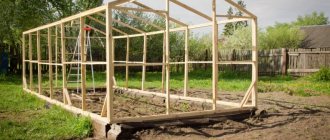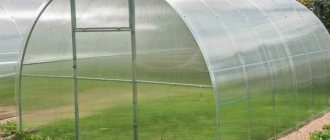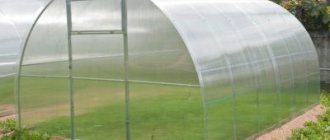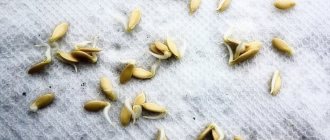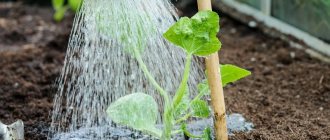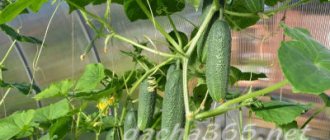There is probably not a single vegetable garden or greenhouse where cucumbers do not grow. And when they also bring a rich harvest, bearing fruit all season long, this is a great joy for any vegetable grower. The creation of certain conditions will serve as a guarantee for this.
This takes into account both the variety and the method of sowing, the time for transplanting into a garden under the open sky or a greenhouse, fertilizer, and moisture. This vegetable is very demanding. But even if all the necessary conditions are met, you may be left with a small harvest due to improper planting.
What scheme should you use to plant cucumbers, how does it affect the yield?
A good harvest is possible thanks to properly planned planting. In fact, there are many schemes for growing cucumbers. It all depends on how, where and what varieties are planted. This can be sowing with seeds or planting seedlings, using open ground or a greenhouse, horizontal or vertical arrangement.
Also, great importance is attached to the nutritional value of the soil. If it is saturated with fertilizers, then the bushes can be planted more densely. The dimensions of the bed also depend on the chosen method.
Transplanting
Seedlings should be planted when the fourth leaf appears, until it has outgrown and is quite strong. Sick plants should not be planted in a greenhouse.
An important point when planting seedlings is that the soil temperature is not lower than +15 degrees. The air temperature in the greenhouse structure is of secondary importance. There must be a thermometer in the greenhouse. It is better to take your temperature in the morning. Experienced gardeners cover the measuring area with plywood or a board to prevent it from being warmed by the sun. The thermometer is placed in the shelter to a depth of 20 cm, leaving it for 15-30 minutes. Thus, the most objective result is obtained.
To speed up the heating of the soil, you can cover it with plastic film or additionally build a warm bed, which should be spilled with hot water to activate the biofuel.
The stages of transplanting seedlings into a greenhouse are as follows:
- Dig holes and fill them with fertilizer. The distance between the cucumber recesses should be at least 40 cm.
- Water the soil for disinfection with a warm solution of potassium permanganate.
- Plant seedlings in the holes, deepening them to the first true leaf.
- Compact the soil around it and cover it with a thin layer of dry soil.
For greater heat retention, you can additionally mulch the beds with cucumbers.
The dangers of illiterate placement of bushes
An incorrect arrangement of bushes will lead to negative consequences. For example, if you plant cucumbers too often, the following troubles may occur:
- The seedlings will stretch out due to lack of light (reduced yield as a consequence).
- Incorrect or insufficient air circulation will provoke stagnation or excess evaporated moisture (the appearance of fungi and the proliferation of pests as a result).
- High humidity will lead to rotting of flowers or the appearance of empty flowers (low yield as a consequence).
When cucumbers are planted too sparsely, the land is used irrationally, which is not at all beneficial from an economic point of view.
Regardless of what cucumber planting scheme is used, it is important to provide good light to the plants during the day. For this purpose, an east-west arrangement of beds is usually used.
The place for planting cucumbers should have good lighting.
Problems and their solutions
Quite often, inexperienced gardeners encounter various problems when growing cucumbers in greenhouse conditions. Let's take a closer look at the most common problems and ways to solve them.
If the leaves turn yellow
This usually indicates a disease or pest problem. Yellowing of foliage is also associated with lack of nutrition. For example, a lack of nitrogen is manifested by pale leaves that begin to turn yellow. The flowers on the plant are small and fall off without opening. With a lack of nitrogen, fruits grow crooked.
The problem is solved by spraying the solution: 1 tbsp. l. urea per 10 liters of water.
No ovaries
The most common reasons for the absence of ovaries are:
- too high humidity in the greenhouse and high air temperature;
- lack of male flowers or pollinating insects;
- lack of nutrition;
- rare harvest: if the fruits are not collected on time, the stems will give all their strength to the overgrowths and will stop setting new fruits.
The problem is solved as follows: place a bucket of manure in the greenhouse and stir it periodically. The carbon dioxide released will have a positive effect on the fruiting of the crop.
How to Attract Bees and Other Pollinating Insects to a Greenhouse
Cucumbers, like many other vegetable crops, are divided into boys and girls. For fruit formation, pollination of flowers by insects is necessary . To attract bees to the greenhouse, you need to spray the plants with water and honey or jam and leave the windows open.
The lower shoots dry out
This is most likely due to too hot weather and lack of moisture. The situation is corrected as follows:
- The lower leaves are torn off.
- The stem is removed from the net and laid on the ground.
- The stem is secured with wire and sprinkled with earth so that the top and leaves with flowers remain on top.
- Plants are watered.
As a result, the stem under the soil will begin to grow roots, and the plants will grow to full growth again.
Irregular fruit shape
Irregular shapes in vegetables can also be due to nutritional deficiencies . For example, a lack of potassium causes the fruits to resemble pears in appearance. It can be easily solved by applying the necessary fertilizers.
Slowly growing
If you encounter this problem, try the following solution:
- In sunny weather, water the beds thoroughly.
- Completely close the room for 1 hour.
- Carefully begin to ventilate the greenhouse.
Cucumbers are bitter
Many summer residents are faced with the fact that cucumbers are bitter, regardless of abundant watering. Most likely, the problem is in the substance cucurbitacin, the amount of which determines the taste of the vegetable.
How to properly grow cucumbers in a greenhouse and open ground
Planting options depend on weather conditions and crop variety. Early cucumbers grow well in open ground, but require protection from possible return frosts with a special covering material or film. To decide on a location, you also need to pay special attention to the method of pollination. Insect-pollinated varieties will produce crops only in the garden. Only self-pollinating species are suitable for greenhouses and greenhouses.
Cucumbers planted with seeds directly into open ground adapt well to weather conditions, the sprouts practically do not stretch, and there is no risk of seedlings dying during replanting. But the seedlings will begin to bear fruit faster. Various schemes are also used depending on the open ground or greenhouse. These schemes allow not only the optimal use of land, but also a rich harvest obtained in a comfortable way.
Harvest.
The fruits reach harvest ripeness 12-15 days after flowering in the spring and after
7-10 days in summer. The fruits of the cucumber hybrids Vyatsky, Molodets, Shik and Charodey can be harvested at different stages of development. For canning as pickles 3-5 cm and as gherkins 5-7 cm. In the summer, with regular removal of fruits from the nodes of hybrids Apollo and Vyatsky, from 1 to 2 fruits are formed, sometimes three. In the hybrids Molodets, Chic and Magician, 2-3 fruits are tied in the nodes. Greens are harvested 2-3 times a week with a length of no more than 12 cm and a diameter of no more than 5 cm. Overgrown fruits left on the plant prevent the development of new ovaries and reduce the yield. Especially if the fruits have been pollinated and seeds have set in them.
Prepared for publication by agronomist A. Zharavin
According to the recommendations of the Ph.D. n. V.M Motov and technologies of NPF "Agrosemtoms".
What should be the distance between individual bushes?
There is also a general scheme that allows you to get a high yield. It is based on what varieties of cucumbers are used and how best to plant them. To answer the question of at what distance to plant cucumbers, you need to decide on a pattern. On average, an interval of 20 cm should be left between seedlings, and about 45 cm between beds.
With a vertical arrangement, it is more convenient to use two rows with a distance between them of about 100 cm. With the horizontal method, the bushes are tied to specially designed pallets using strong nylon thread or wire.
So, it is better to place 3–4 bushes on one square meter. Below is an approximate landing diagram:
Scheme of planting cucumbers in a greenhouse.
On a note! From the wall of the greenhouse to the bush you need to leave about 30 cm, but no less. This will help with good air exchange. Also, this method ensures optimal temperature conditions, because the walls quickly heat up and cool down, which can lead to either overheating and burning of the plant, or to freezing.
How to care for culture
Cucumbers are one of the most common vegetable crops. Caring for plants is easy. Every novice gardener can cope with the job if he adheres to certain rules.
Preparing for landing
During preparation, the soil is dug up, adding a sufficient amount of minerals. This will destroy harmful insects in the soil layer. It is better to dig the soil twice.
Cucumber seeds are also prepared for planting. Check the packaging first. It must not be expired. Then remove the seeds and inspect them carefully. Remove rotten ones.
All seeds are placed in a glass and filled with salted water. Taking a spoon, I stir the contents of the container. After 10-15 minutes, remove with a spoon those specimens that float on the surface, as they have lost their vitality. Seeds that have sunk to the bottom are suitable for planting. They will germinate quickly.
The seeds are placed in the refrigerator for several hours. They become immune to diseases.
Seeds are disinfected by freezing in a potassium permanganate solution. They keep them here for half an hour.
Then the seeds are transferred to damp gauze or a cloth and wrapped. The seeds are checked every day. If the fabric is dry, moisten it a little with water. When the seeds have hatched, they are planted.
Landing
Place soil in a small container, make holes and spill them with settled water. The seeds are placed at a certain distance and covered with soil.
Place plastic film or glass on the container and place it in a warm place. When the seedlings sprout, remove the cover and move the container to the windowsill. This provides sufficient light. To prevent the seedlings from dying, it is recommended to lightly illuminate them.
When 3-4 true leaves appear, the plants dive, planting them in separate containers.
When the cucumbers grow enough, you can plant them in a permanent place. To do this, make holes and plant one seedling in each, trying not to damage the root system. Water with sufficient amount of water.
Temperature
It's quite hot in the greenhouse. To normalize the temperature, open the door and several windows in hot weather. This measure will help avoid spoilage of fruits and eliminate the spread of dangerous diseases and insect pests.
Watering
Water the crop regularly. There are several watering options:
- With drip, moisture is delivered in doses to each bush.
- The intensive method involves thoroughly watering the plant. Water the cucumbers under each bush.
Be careful not to get water on the plants. Otherwise, the seedlings may be damaged.
Settled water is suitable for irrigation. If you take it cold, it will lead to the spread of dangerous diseases.
Treatment
In order for plants to grow well and produce a harvest, they need to be fed. The procedure is carried out several times:
- Fertilizers are applied for the first time when preparing the soil.
- The seedlings are fed a second time at the time of planting.
- The third time the soil is fertilized when the plants begin to bloom.
When the fruits begin to fill, you should not feed them. This will lead to the accumulation of harmful substances in the vegetable, which will lead to harm to humans.
The lashes are sprayed with special preparations against insect pests. The procedure is carried out before the fruiting process begins.
To help plants grow better, loosen the soil regularly, removing weeds. If this is not done, harmful plants will draw life-giving force from the cucumbers.
Layout of cucumbers in greenhouses and greenhouses
Initially, you need to prepare a greenhouse (usually made of polycarbonate) or a greenhouse for the seedlings. A place on a flat area, or with a slight slope to the south, is better suited. Ventilation must be provided during particularly hot summer months.
The optimal conditions for the growth of cucumbers are warmth and humidity. There are many varieties of beds, but one or another option is selected according to the dimensions of the greenhouse. One of them is when the bed itself is located higher above the ground. The bottom is covered with drainage material. A mixture of soil and humus is leveled on top. The height is usually about 25-30 cm. The width is up to 100 cm, the length depends on the size of the greenhouse.
Here it is customary to use the following planting schemes:
- two-line (two-row);
- in a checkerboard pattern;
- single-line (single-row).
Below is a schematic diagram of methods for planting cucumbers in greenhouses and greenhouses.
Schemes for planting cucumbers in one and two rows, as well as in a checkerboard pattern.
The first involves planting two rows at once in one wide bed. The distance between cucumber seedlings in one row is maintained up to 40 cm, and between rows up to 50 cm. It is recommended to leave the gaps between the lines from 70 to 90 cm.
The planting density of plants is directly proportional to the dimensions of the greenhouse itself. Accordingly, the larger they are, the greater the distance between the bushes and the more favorable it will be for them.
So, for example, with a greenhouse width of 2 m, it will be convenient to plant as follows:
- from the walls of the greenhouse to the bush 20 cm;
- the distance between cucumber bushes in a greenhouse in one row is 40 - 45 cm;
- between rows 70 - 80 cm.
With a greenhouse width of 2.5 m:
- from the walls of the greenhouse 30 - 35 cm;
- between plants in one row 50 cm;
- between rows 80 - 90 cm.
With a greenhouse width of 3 m, you can plant three rows of cucumbers:
- from the walls of the greenhouse 15 cm;
- between plants in one row 50 cm;
- between rows 70 cm.
The checkerboard pattern is suitable for areas with a width of 2 to 3 m. Here the bushes are planted in two rows in a checkerboard pattern. When planting, the distance between cucumbers in the greenhouse is about 35 cm. The offset in the rows allows you to minimize the density of the beds. Cucumbers do not intertwine with each other during growth, and this, in turn, is very convenient when caring for and harvesting.
Another type of planting cucumbers in a greenhouse is single-line. It involves placing the bushes in one row at a distance of 20–40 cm, leaving about 70 cm between the rows themselves.
Each landing option has both its pros and cons. For example, a two-row allows you to plant a larger number of bushes, and, accordingly, harvest a larger harvest. With a checkerboard pattern, good illumination is ensured, and, consequently, good growth. Single-row is popular due to its ease of care for each plant.
It is better to choose a scheme based on the characteristics of the variety chosen for cultivation. Here such indicators as the abundance of leaf mass, the height of the bushes, the size of the side shoots and their number are taken into account.
Tall hybrid crops are preferably planted in single rows. But varieties of cucumbers with a small number of branches and long fruits like a checkerboard pattern. This way each bush receives the necessary light without interfering with each other.
Check out another cucumber planting scheme. This option is suitable for both open ground and greenhouses.
Grafting onto the root of another plant
The weakest point of any greenhouse cucumber is a bad root. Too small, too delicate, which makes caring for plants quite difficult. Therefore, many greenhouse owners practice grafting onto another root, for example, pumpkin.
Such a plant will be much stronger and healthier. Try it, it's not difficult:
Some summer residents also quite successfully graft vegetables onto laginaria, because it has a more powerful root system, which is also more hardened - it quietly performs its functions even at +8°C.
The most common mistakes when landing
No one is immune from making mistakes. So planting cucumbers cannot be done without them. The main ones:
- overexposure of seedlings;
- density in the bed;
- incorrect crop rotation.
The first mistake is failure to meet the disembarkation deadlines. The optimal time is a month after seed germination. If the seedlings are left too long, a nutritional deficiency occurs, which leads to wilting when planted in the ground. Too dense planting leads to small fruits, poor harvests, and the appearance of fungal diseases.
Re-planting of the fruit, i.e. Growing the same crop in the same place will lead to deterioration and reduction in yield. Cucumbers will become more vulnerable to disease. It is also not recommended to plant them after pumpkin crops.
But the location where tomatoes, legumes, cabbage or greens grew last season is considered favorable. Having made certain mistakes, it is important to correct them in time and gain valuable experience from this. After all, only those who do nothing make mistakes.
To summarize, we can say that the choice of planting scheme for cucumbers depends on a number of factors. These include the timing of crop ripening, frost resistance, pollination method, and others. Through trial and error, each gardener will find the best option that suits him.
Soil preparation
For sowing cucumber seeds, it is preferable to use peat pots rather than reusable containers. This is due to the fact that the crop does not like replanting when its root system is disturbed.
Soil for filling seed containers can be purchased in specialized stores and departments. This soil mixture will be disinfected and has a special composition suitable specifically for growing cucumbers.
The second option for obtaining soil for planting seeds is to prepare it yourself. To do this, take the following ingredients and mix them thoroughly:
- turf - 1 part;
- compost - 2 parts;
- peat - 1 part;
- sand - 1 part.
Such a soil mixture should be subjected to a disinfection procedure before use. To do this, you can use one of the options:
- heat it in the oven at a temperature of 170-180 degrees for 20 minutes;
- process in a special steam generator for half an hour;
- dilute 15 ml of Fitosporin in 10 liters of water and pour over the soil.
After processing, it is necessary to add fertilizer to the planting mixture to enrich it with nutrients and elements. For 10 kg of soil add:
- wood ash - 200 g;
- phosphorus fertilizers - 50 g;
- potassium sulphide - 35 g.
After thoroughly mixing the mixture, it must be moistened. High-quality soil is ready for sowing cucumber seeds.

